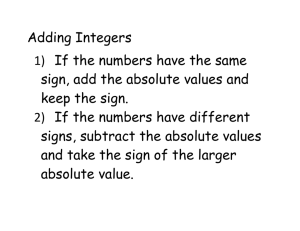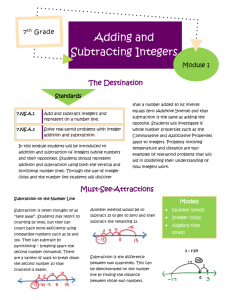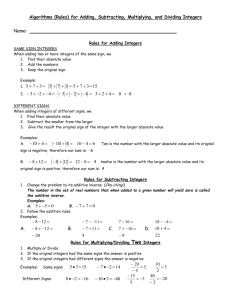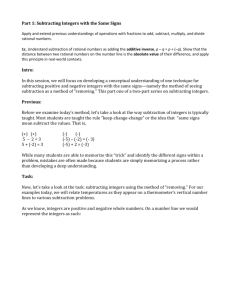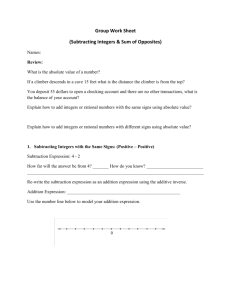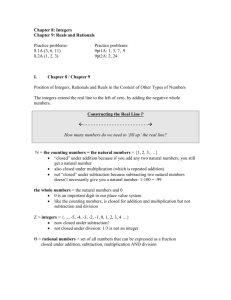Adding and Subtracting Integers
advertisement
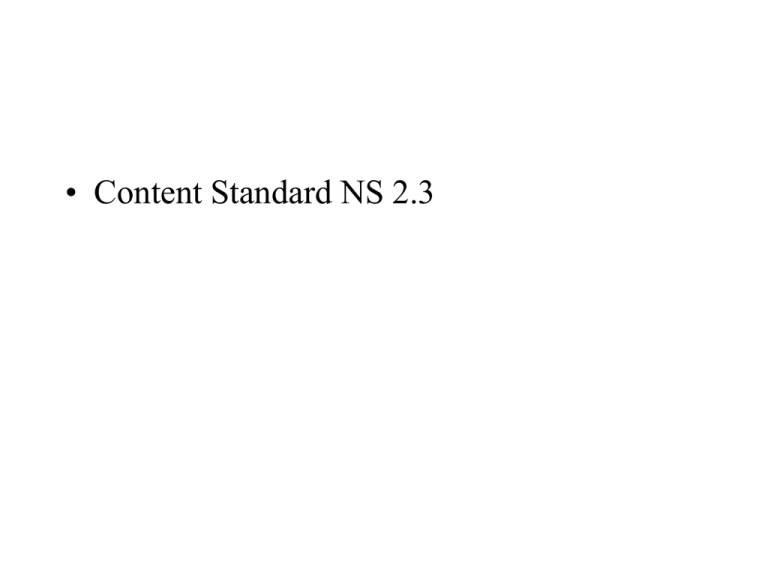
• Content Standard NS 2.3
Homework: pg 138 (16-54 even only)
pg 145 (4-26 even only)
DO NOW:
Compare and order these fractions and decimals.
1)
.60
4
10
2)
4
20
1
2
.75
.4
Adding and Subtracting Integers!
Standard: NS 2.3 Solve addition, subtraction,
multiplication, and division problems, including those
arising in concrete situations that use positive and
negative integers and combinations of these operations.
Objective: Students will solve addition and
subtraction problems, including those arising in
concrete situations that use positive and negative
integers by using rules and steps, synthesizing
information on positive and negative integers,
creating graphic organizers, applying math facts
skills, writing reflective summaries, and scoring an
80% proficiency on exit slip quiz.
Objectives
The student will be able to:
1. State the coordinate of a point on a
number line.
2. Graph integers on a number line.
3. Add and subtract integers.
The Number Line
-5
0
5
Integers = {…, -2, -1, 0, 1, 2, …}
Whole Numbers = {0, 1, 2, …}
Natural Numbers = {1, 2, 3, …}
To GRAPH
a set of numbers means to locate and
mark the points on the number line.
Graph {-1, 0, 2}.
-5
• •
0
•
5
Be sure to put the dots on the line not above or below.
Name the set of numbers graphed.
-5
• • 0• • • • • 5• •
{-2, -1, 0, . . . }
The darkened arrow means that the
graph keeps on going. When you
see this, put 3 dots in your set.
Examples: Use the number line if
necessary.
-5
0
1) (-4) + 8 =
4
2) (-1) + (-3) =
-4
3) 5 + (-7) =
-2
5
Addition Rule
1) When the signs are the same,
ADD and keep the sign.
(-2) + (-4) = -6
2) When the signs are different,
SUBTRACT and use the sign of the
larger number.
(-2) + 4 = 2
2 + (-4) = -2
Karaoke Time!
Addition Rule: Sung to the tune of
“Row, row, row, your boat”
Same signs add and keep,
different signs subtract,
keep the sign of the higher number,
then it will be exact!
Can your class do different rounds?
-1 + 3 = ?
1.
2.
3.
4.
-4
-2
2
4
Answer Now
-6 + (-3) = ?
1.
2.
3.
4.
-9
-3
3
9
Answer Now
The additive inverses (or opposites)
of two numbers add to equal zero.
Example: The additive inverse of 3 is
-3
Proof: 3 + (-3) = 0
We will use the additive inverses for
subtraction problems.
What’s the difference between
7 - 3 and 7 + (-3) ?
7 - 3 = 4 and 7 + (-3) = 4
The only difference is that 7 - 3 is a
subtraction problem and 7 + (-3) is
an addition problem.
“SUBTRACTING IS THE SAME
AS ADDING THE OPPOSITE.”
(Keep-change-change)
Subtracting Rule!
When subtracting, change the subtraction to
adding the opposite (keep-change-change)
and then follow your addition rule.
Example #1:
- 4 - (-7)
- 4 + (+7)
Diff. Signs --> Subtract and use larger sign.
3
Example #2:
-3-7
- 3 + (-7)
Same Signs --> Add and keep the sign.
-10
Okay, here’s one with a variable!
Example #3: 11b - (-2b)
11b + (+2b)
Same Signs --> Add and keep the sign.
13b
1.
2.
3.
4.
Which is equivalent to
-12 – (-3)?
12 + 3
-12 + 3
-12 - 3
12 - 3
Answer Now
7 – (-2) = ?
1.
2.
3.
4.
-9
-5
5
9
Answer Now
Review
1) If the problem is addition, follow
your addition rule.
2) If the problem is subtraction, change
subtraction to adding the opposite
(keep-change-change) and then follow
the addition rule.
Absolute Value
of a number is the distance from
zero.
Distance can NEVER be negative!
The symbol is |a|, where a is any
number.
Examples
7 = 7
10 = 10
-100 = 100
5 - 8 = -3= 3
|7| – |-2| = ?
1.
2.
3.
4.
-9
-5
5
9
Answer Now
|-4 – (-3)| = ?
1.
2.
3.
4.
-1
1
7
Purple
Answer Now
The set of numbers containing
all positive and negative
whole numbers and zero
Integer



